Common Name
Flexiseps decaryi
Scientific Name
Flexiseps decaryi
Habitat
Flexiseps decaryi, commonly known as Decary’s skink, is primarily found in the unique and biodiverse regions of Madagascar. This species thrives in rainforests and savannas, where the warm and humid climate creates a perfect microhabitat for its survival. Preferring the understory vegetation, Decary’s skink is often associated with areas that provide ample cover and access to a rich variety of prey. The combination of moist environments and diverse foliage not only offers protection from predators but also ideal conditions for hunting and foraging.
Physical Characteristics
Decary’s skink is a medium-sized lizard, typically measuring between 15 to 25 cm in length. Its elongated body is complemented by short, stout legs and a distinctive long tail, which can detach as a defense mechanism against predators. The skin of Flexiseps decaryi presents a striking coloration, ranging from deep browns to vibrant greens, often adorned with intricate patterns that aid in camouflage within its leafy surroundings. One unique feature of this species is its smooth, shiny scales, which are not only visually appealing but also functionally beneficial in reducing water loss in its humid habitat.
Behavior
Flexiseps decaryi exhibits a range of fascinating behaviors that contribute to its survival. These skinks are primarily diurnal, active during the daytime when they forage for food. Their social interactions are typically solitary, although they may be observed basking in the sun in proximate proximity to one another. In terms of reproductive behavior, Decary’s skink engages in elaborate mating displays; males often compete for territory and showcase their agility in pursuit of females. During the mating season, these skinks may display bold coloration enhancements, signaling their readiness to breed.
Diet
Flexiseps decaryi is classified as an insectivore, primarily feeding on a diet composed of insects and other small invertebrates. Their diet may include ants, beetles, and soft-bodied insects, which they hunt using quick reflexes and the element of surprise. These skinks are known for their foraging behaviors that involve sifting through leaf litter and examining crevices in search of prey. The availability of insects in their habitat plays a critical role in their dietary patterns, making them important natural pest controllers.
Reproduction
The reproductive cycle of Flexiseps decaryi typically occurs in the warmer months, aligned with the seasonal climate of Madagascar. Mating rituals involve males performing courtship displays, which may include physical posturing and colorful displays to attract females. After successful mating, females lay 2 to 6 eggs per clutch in secure, moist locations, such as under leaf litter or burrows. The incubation period lasts approximately 60 to 80 days, after which hatchlings emerge fully formed and capable of independent survival. Parental care is minimal, with females providing no further protection after laying eggs.
Conservation Status
As of the latest assessments, Flexiseps decaryi is listed as vulnerable by the International Union for Conservation of Nature (IUCN). This status is primarily attributed to habitat loss due to deforestation, agricultural expansion, and climate change. Conservation efforts are underway to protect Madagascar’s unique biodiversity, including the establishment of protected areas and habitat restoration initiatives. However, challenges persist, as illegal logging and land development continue to threaten the natural habitats crucial to the survival of this skink.
Interesting Facts
One of the most intriguing facts about Flexiseps decaryi is its ability to lose its tail as a defense mechanism— a trait known as autotomy. This adaptation not only allows for escape from predators but can also confuse attackers, increasing the skink’s chances for survival. Additionally, Flexiseps decaryi is known for its remarkable climbing abilities; it can scale vertical surfaces with ease, utilizing its sharp claws and strong limbs to navigate its forested habitat skillfully. These unique adaptations contribute to its resilience in the face of environmental challenges.
Role in Ecosystem
Flexiseps decaryi plays a vital role in the ecology of Madagascar’s terrestrial ecosystems. As an insectivore, it helps regulate insect populations, assisting in maintaining the balance within its habitat. This skink serves as both predator and prey, contributing to the food web dynamics. By consuming insects, Decary’s skink indirectly supports plant health through pest control, illustrating its importance as a beneficial species within the forest ecosystem. Moreover, its presence can indicate the overall health of the ecosystem, acting as a bioindicator for environmental changes.
